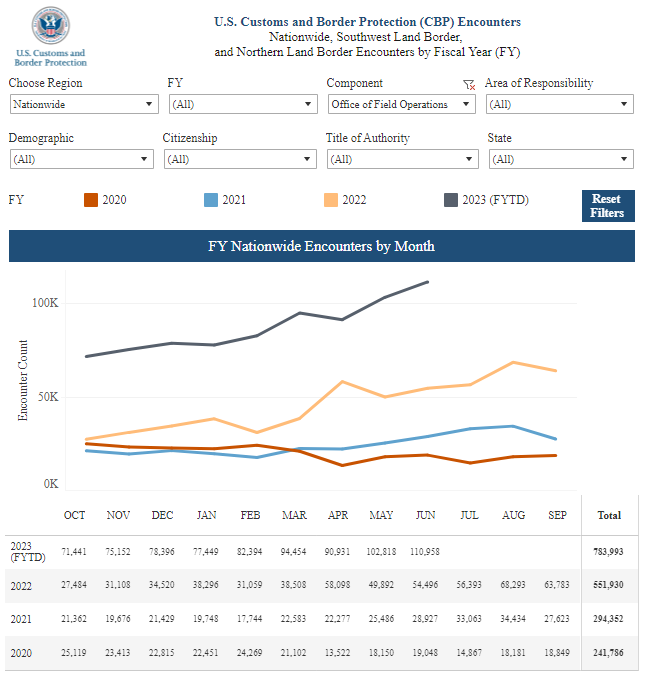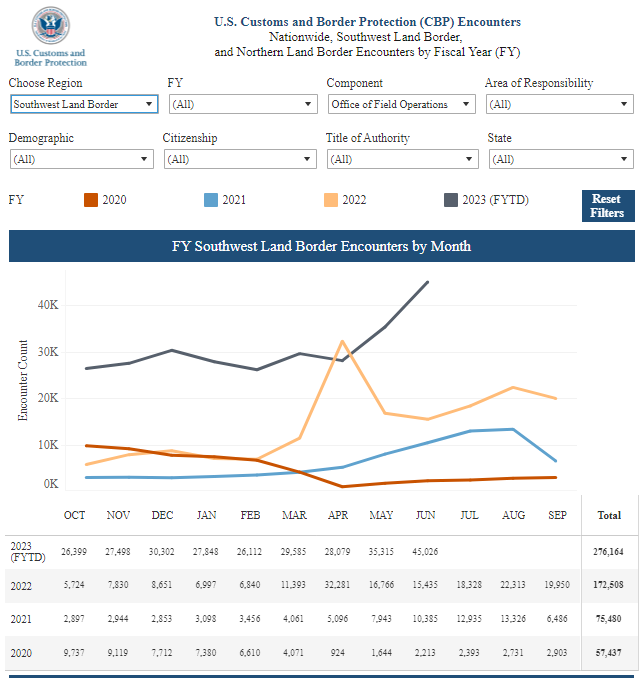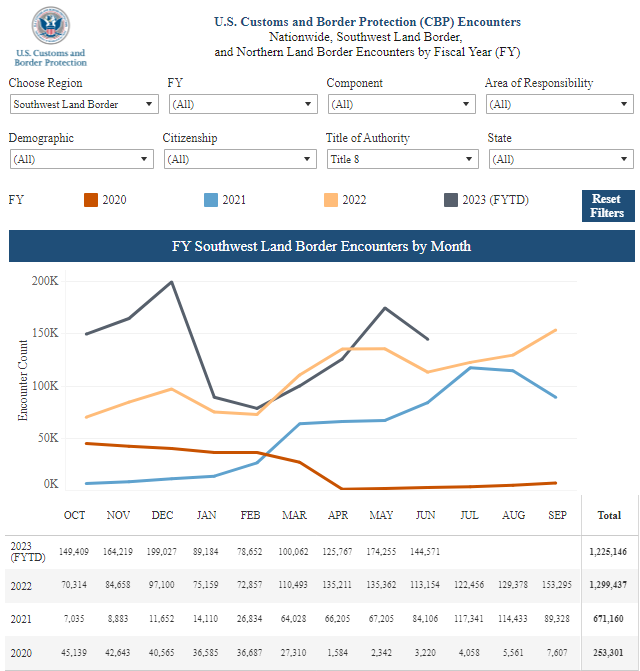CBP has put out its “Nationwide Encounters” statistics for June. Those stats are a compilation of the number of aliens apprehended by Border Patrol agents along all U.S. borders plus aliens deemed inadmissible by CBP officers in the agency’s Office of Field Operations component (OFO) at all U.S. ports of entry (collectively known as “encounters”). They reveal that the Biden administration’s plan to funnel would-be illegal migrants through the ports is going gangbusters — and pushing the number of inadmissible aliens stopped at the Southwest border to new records.
“Nationwide Encounters”. In June, CBP officers in OFO stopped nearly 111,000 inadmissible aliens at the Southwest, Northern, Coastal, and interior ports of entry. That’s a 7.6 percent increase compared to May, but more importantly, it’s more than double the overall number of OFO encounters in June 2022 (just short of 54,500), and nearly three times the encounter figure for June 2021 (fewer than 25,500).

While I’ll delve into the Southwest OFO port figures below, it’s important to realize that the number of aliens deemed inadmissible at the interior airports and coastal ports of entry has surged in the past two years as well.
More than 50,000 aliens were deemed inadmissible at just U.S. airports and coastal ports in June, nearly as many as at all U.S. ports of entry (including Southwestern and Northern ports) in June 2022, and almost exactly three times as many as at the airports and seaports in June 2021 (16,753).
Nearly all of those encounters were at airports (the number of seaborne migrants has been on the rise of late, but there are still too few to make much difference in the overall figure), which should raise red flags to anyone who’s ever travelled abroad by air.
With extremely limited exceptions, airlines won’t allow passengers on international flights unless they have: (1) a ticket; (2) a passport; and (3) a visa to enter the country in which the plane lands. That’s not only because it’s illegal, but also because the airline itself may be on the hook for shipping inadmissible fliers back.
“VNHC Parole Program”. So, how did some 50,000 inadmissible passengers make it to international airports in the United States in June? Good question, but I can tell you why OFO encountered 6,199 Venezuelans, 4,703 Nicaraguans, 10,911 Haitians, and 8,378 Cubans there in June. Here’s why nearly all those aliens are on the list.
In January, the White House announced it was expanding a (facially illegal) “parole” program for Venezuelan nationals to also offer two-year grants of parole to nationals of Nicaragua, Haiti, and Cuba as well, at a rate of some 30,000 per month or 360,000 per year. For simplicity’s sake, I refer to it as the “VNHC parole program”.
And here’s why that program is “facially illegal”. Parole in the immigration context refers to an authority Congress gave DHS to allow otherwise inadmissible aliens to enter the United States for a temporary period without being formally admitted.
That power is extremely circumscribed by statute. It permits DHS to parole and release aliens into the United States “only on a case-by-case basis for urgent humanitarian reasons or significant public benefit”. The first problem is that this program is not implemented on a case-by-case basis.
Instead, as USCIS explains on its website, it selects the lucky recipients of those paroles largely by pure chance, “randomly select[ing]” half of the total from the pile of sponsor applications filed that month, and the other half from the pile of ungranted sponsor applications previously filed but not granted, “based on when the case was submitted under the first-in, first-out method”.
That’s a “case-by-case” basis to the degree that the lottery “only” gives prize money to winners. But those winners get the money regardless of whether they need it or not and regardless of whether the country benefits from the winners having the money.
Which brings me to the statutory requirement that parole only be granted “for urgent humanitarian reasons or significant public benefit”.
The parole authority has been in the Immigration and Nationality Act (INA) since 1952, but Congress put further restrictions on it in 1996 to curb abuses of the power by various administrations. Here’s how the former Immigration and Naturalization Service (“INS” the precursor to USCIS in adjudicating immigration benefits) explained that power under the earlier, more expansive version of that parole power in 1982:
The legislative history of the parole provision shows a Congressional intent that parole be used in a restrictive manner. The drafters of the [INA] of 1952 gave as examples situations where parole was warranted in cases involving the need for immediate medical attention, witnesses, and aliens being brought into the United States for prosecution. ... In 1965, a Congressional committee stated that the parole provisions “were designed to allow the Attorney General to act only in emergent, individual, and isolated situations, such as in the case of an alien who requires immediate medical attention, and not for the immigration of classes or groups outside the limit of the law. [Emphasis added.]
Again, Congress has only further restricted DHS’s parole authority in the intervening 51 years, which gives you an idea of how tightly cabined that power is now. And of course, granting 360,000 aliens without visas entry to the United States is “outside the limit of the law”, that is, the restrictions Congress placed on the annual number of immigrants who may be admitted to the United States.
So on what basis has the administration decided to grant two years’ parole under this program? Do those individuals all need life-saving surgery, or to come here to answer criminal charges? No. According to USCIS, the administration dreamed up this program “to reduce the irregular migration of Cubans, Haitians, Nicaraguans, and Venezuelans”. Once again, let me explain.
The Biden administration has struggled to deal with record levels of illegal migrants crossing the Southwest border and with illegal Venezuelans, Nicaraguans, Haitians, and Cubans, in particular.
In FY 2022, Border Patrol agents at the Southwest border apprehended more than 187,000 Venezuelans, 163,500-plus Nicaraguans, 29,000 Haitians, and more than 220,000 Cubans.
Even if it tried to remove illegal entrants (which the Biden administration has largely restricted), DHS would have difficulty deporting Venezuelans, Nicaraguans, and Cubans due to our poor diplomatic relations with those countries, and the administration has apparently decided that Haiti is unfit to return anyone to (although the country does have a population of more than 11.7 million).
So, to encourage (read: “attempt to buy off”) them not to enter illegally, the White House concocted the VNHC parole program, despite the fact that it seems like handing out gift cards to random people in given neighborhoods to prevent shoplifting.
Note that in FY 2019, Border Patrol agents at the U.S.-Mexico line apprehended just 2,202 Venezuelans, 13,309 Nicaraguans, 2,046 Haitians, and 11,645 Cubans — less than 5 percent of the flow from those four countries than in FY 2022, suggesting if not proving that Biden’s “catch-and-release policies” have more to do with their illegal migration to the United States than conditions back home.
In any event, “reducing the irregular migration of” nationals of the four countries satisfies neither the “urgent humanitarian reasons” nor the “significant public benefit” prongs of DHS’s parole authority, as reference to the INS’s 1983 analysis of that authority above demonstrates.
Of course, few of the beneficiaries of the VNHC parole program are likely to leave after two years. As one senior DHS official told CBS News: “If they, at the end of the two years, have not found a lawful pathway in the U.S., our expectation is that we will be seeking to remove those individuals”.
But Biden’s DHS was unable to keep track of the tiny population of 2,576 aliens under a perturbed judge’s microscope it paroled the day after Title 42 ended, which shows that even if DHS “seeks to remove the” 30,000 VNHC beneficiaries it’s paroling in every month two years hence, its efforts will be fruitless.
Not surprisingly, DHS’s failure to plan to enforce those two-year VNHC entry grants is one of the bases on which a group of 20 state plaintiffs is suing the administration to stop the parole program, in Texas v. DHS.
Record OFO Southwest Border Encounters in June. In June, OFO officers at the Southwest border ports of entry encountered more than 45,000 inadmissible aliens — a monthly record for port encounters there, and it’s not even close.

CBP didn’t publish specific monthly statistics for Southwest OFO encounters prior to FY 2017, but it did publish total monthly numbers for CBP encounters (again, both Border Patrol apprehensions and aliens deemed inadmissible at the ports) there going back to FY 2012 (a point I’ll return to below).
In the 60 months between October 2011 and September 2016, total CBP monthly encounters at the Southwest border topped 45,000 just 18 times: March and April 2012; March through May 2013; March through July 2014; October through December 2015; and March, May, June, July, and August 2016.
The largest number of monthly CBP encounters during that five-year period came in May 2014, when agents and CBP officers encountered more than 68,000 aliens there. CBP statistics reveal that nearly 60,700 of the encounters that month were Border Patrol apprehensions, meaning that just 8,111 involved aliens deemed inadmissible by OFO at the ports.
Total monthly OFO encounters along the Southwest border thereafter (prior to the Biden administration) peaked in October 2016, when just over 20,524 aliens were stopped at the ports as aliens tried to rush in just before Trump took office.
In all of FY 2018, just more than 124,000 inadmissible aliens were stopped at the Southwest border ports (never more than 11,600 in any month), and despite the fact that Border Patrol Southwest border apprehensions spiked in FY 2019 (when agents apprehended 851,508 illegal migrants), just 126,001 aliens were deemed inadmissible at the ports there, and never more than 12,040 in any month.
Biden changed that dynamic, as OFO encounters at the Southwest border ports topped 10,000 for the first time in history in June 2021 (10,385), and then briefly exceeded 32,000 in April 2022. Most (more than 20,000) of those aliens were Ukrainians, seeking to take advantage of yet another administration program.
The CBP One App Port Interview Scheme. OFO encounters at the Southwest border ports really jumped starting in October, thanks to a secret Biden plan my colleague Todd Bensman uncovered in November that allowed would-be illegal migrants to circumvent Title 42 exclusion by scheduling appointments at the ports using the CBP One app.
The White House came clean about that program in the same January “fact sheet” it used to announce the VNHC parole program. It explained:
When Title 42 eventually lifts, noncitizens located in Central and Northern Mexico seeking to enter the United States lawfully through a U.S. port of entry have access to the CBP One mobile application for scheduling an appointment to present themselves for inspection and to initiate a protection claim instead of coming directly to a port of entry to wait. This new feature will significantly reduce wait times and crowds at U.S. ports of entry and allow for safe, orderly, and humane processing.
There are many misstatements of fact and law in that paragraph, as I have explained numerous times in the past, but two tarradiddles stick out. First, aliens who show up at the ports without proper admission documents aren’t “seeking to enter the United States lawfully”. You can read my detailed analysis if you need proof, or you can just consider that they wouldn’t count as “encounters” if they were coming lawfully.
Second, that program — which I call the “CBP One app port interview scheme” — didn’t start “when Title 42 eventually lifted” (on May 11); it was rolled out a week after that announcement on January 12, as CBP has subsequently admitted.
By the end of May, more than 106,000 would-be illegal migrants cum inadmissible “applicants for admission” who had scheduled interviews using the CBP One app were processed through the ports, and in April it was reported that more than 99 percent of them were allowed to enter the United States.
This scheme was officially promulgated in a final regulatory rule captioned “Circumvention of Lawful Pathways” (my colleague George Fishman helpfully shortened it to the “CLAP rule”), published in the Federal Register by DHS and DOJ on May 16, backdated to May 11.
Under the CLAP rule, the asylum and protection claims of aliens who cross the border illegally between the ports are subject to a higher level of scrutiny, while those who take advantage of the CBP One app port interview scheme have their claims considered under the (much looser) prevailing standards.
Well, that’s what the administration claims. In May, CBP both lifted a requirement that aliens who take advantage of the scheme show up at a time certain (they can now appear at any point in a 23-hour window) and expanded the number of available interview slots from 1,000 per day to 1,250; in June, the number of CBP One port interview slots was expanded further, to 1,450 daily — or 529,000-plus per year.
There’s no way CBP officers at the ports can reasonably evaluate protection claims made by 1,450 CBP One app interviewees per day, and especially no way they can do so for aliens who appear at 11:00 at night. And there’s really, really no way they can vet more than 99 percent of those 1,450 aliens per day in any meaningful way before releasing them into the United States.
This is nothing more than a shell game concocted by carnies at the White House and DHS to hide the millions of aliens the Biden administration is allowing to pour over the Southwest border into the United States. Worse, it’s criminally reckless, as it flouts not only our norms and laws but also the very security of the nation and of towns and cities nationwide to which those aliens are headed.
But at least it allows the Biden administration to crow that Border Patrol apprehensions at the U.S.-Mexico line have now fallen below 100,000 per month — for now.
That won’t last regardless of how many aliens the administration slugs through the ports daily using this scheme, because the number of foreign nationals “seeking a better life” in the United States is, for all practical purposes, infinite, and this scheme just invites more to come.

“CBP Title 8 Encounters” — The Best Way to Look at the Border Now. Given that the Biden administration has turned the Southwest border port system from a barrier that prevents inadmissible aliens from being admitted into the United States into a sluice through which they can pour in increasing numbers, it’s time for a paradigm shift in how objective observers view the border.
The best way to look at the number of illegal aliens coming in monthly is to view them not individually as separate Border Patrol apprehensions and aliens deemed inadmissible at the ports, but holistically as CBP “Title 8 encounters” at the Southwest border, especially now that Title 42 has ended. It’s the truest view of how many aliens are attempting to enter illegally, and how DHS’s been viewing it since FY 2012.
And given the fact that, thanks to the Biden administration’s overarching non-detention policies, nearly all of them are going to be allowed into the country, it provides voters the clearest window into what the president (and his White House and DHS carnies) are doing.
From that perspective, June — at more than 144,000 total CBP Title 8 Southwest border encounters — was the sixth worst month since March 2006, trailing just December (199,027), May (174,255), November (164,219), September (153,295), and October (149,409). In the first nine months of FY 2023, CBP has had nearly as many Southwest border Title 8 encounters (1.225 million) as in all of FY 2022 (1.299 million).
CBP has also had — again in just nine months — 182.5 percent as many Title 8 encounters as in all of FY 2021 (671,160), nearly four times as many as in FY 2020 (253,301), and — most telling — 25 percent more than in FY 2019 — as year so bad at the Southwest border that the then-DHS secretary had to declare a “border emergency”.
The sooner the American people and their representatives realize the Biden administration is playing a shell game at the Southwest border using various illegal schemes and programs to hide the actual number of illegal migrants it is allowing into the United States, the better. Because the problem is bad from a national-security and law-enforcement viewpoint — and it’s about to get a whole lot worse.
